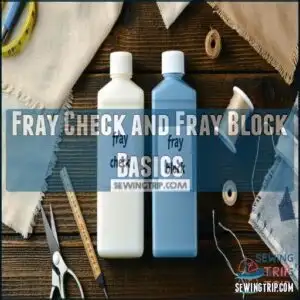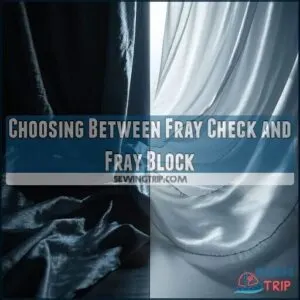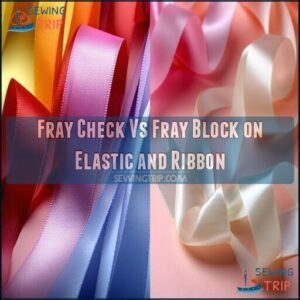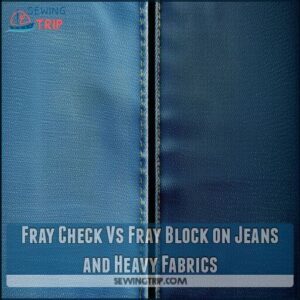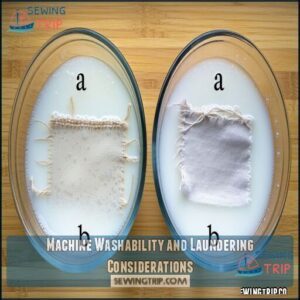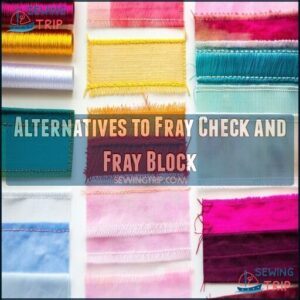This site is supported by our readers. We may earn a commission, at no cost to you, if you purchase through links.
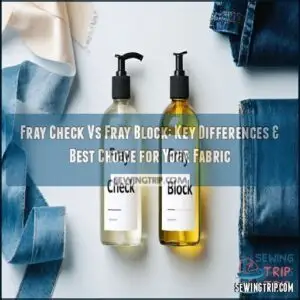 When deciding between Fray Check and Fray Block, it’s all about the fabric and finish you need.
When deciding between Fray Check and Fray Block, it’s all about the fabric and finish you need.
Fray Check dries stiff and clear, making it perfect for heavy-duty projects like denim or canvas.
On the other hand, Fray Block dries flexible, so it’s better for lightweight or stretchy fabrics where stiffness isn’t ideal—think ribbons or delicate knits.
Fray Block’s gel-like consistency also means less dripping, but it needs heat to fully set.
Both are machine washable, but Fray Check might need reapplication over time, which is why picking the right product is easier when you match it to your fabric’s personality and purpose!
Table Of Contents
- Key Takeaways
- Fray Check and Fray Block Basics
- Choosing Between Fray Check and Fray Block
- Fray Check Applications and Techniques
- Fray Block Applications and Techniques
- Fabric Compatibility and Best Use Cases
- Cost-effectiveness and Availability Comparison
- Fray Check Vs Fray Block on Elastic and Ribbon
- Fray Check Vs Fray Block on Jeans and Heavy Fabrics
- Machine Washability and Laundering Considerations
- Alternatives to Fray Check and Fray Block
- Frequently Asked Questions (FAQs)
- Conclusion
Key Takeaways
- You’ll want Fray Check for stiff, durable finishes on heavy fabrics like denim, while Fray Block is better for soft, flexible finishes on delicate fabrics like silk or ribbons.
- Fray Block dries faster (10 minutes) and maintains fabric flexibility, while Fray Check takes longer (30 minutes) and creates a stiffer, more durable bond.
- Use Fray Block for precise work on delicate edges thanks to its gel-like consistency, while Fray Check is ideal for larger areas or heavy-duty materials.
- Both are washable, but Fray Check lasts longer on high-stress areas, whereas Fray Block may need reapplication for consistent results.
Fray Check and Fray Block Basics
When you’re tackling frayed fabric edges, Fray Check and Fray Block are two popular options that get the job done.
Both products use alcohol-based formulas but differ in texture, drying time, and flexibility to suit different sewing needs, making them suitable for various applications with different sewing requirements.
Origins and Manufacturers of Fray Check and Fray Block
Fray Check and Fray Block have been the go-to fabric edge sealants for years, saving countless projects from falling apart. Dritz Corporation launched Fray Check in the mid-1970s, creating a stiff, durable solution to stop fraying. Around twenty years later, June Tailor Inc introduced Fray Block, giving crafters a softer, more flexible option.
Trusted by crafters for decades, Fray Check and Fray Block are the ultimate solutions to keep fabric edges clean and secure.
These two products come with impressive histories. Both are proudly made in the U.S., reflecting their companies’ commitment to quality. Over time, their formulas have remained steady, proving their reliability in the sewing world. Dritz Fray Check is also useful for securing thread ends on embroidery.
Here’s what sets their stories apart:
- Dritz Corporation keeps Fray Check’s original formula intact.
- June Tailor Inc manufactures Fray Block in Wisconsin with an eye on quality control.
- Each brand has battled new competitors while staying iconic.
- Development timelines highlight steady improvements without overhauls.
Choosing either taps into decades of trusted crafting expertise.
Chemical Composition of Both Products
When comparing fray check and fray block, it’s all about their chemical makeup.
Fray check relies on vinyl acetate polymers dissolved in an alcohol solvent, creating a firm, stiff finish perfect for heavy-duty fabrics. Meanwhile, fray block features an acrylic base blended with soft polyamides, delivering superior flexibility that’s ideal for delicate materials.
| Property | Fray Check | Fray Block |
|---|---|---|
| Base | Vinyl acetate | Acrylic polymers |
| Texture when dry | Stiff, firm | Soft, flexible |
| Discoloration potential | Higher | Lower |
Both solutions use distinct bonding mechanisms to prevent fraying, but their polymer differences make each better for specific needs. Choose wisely based on your project!
Primary Purposes and Applications
Stopping fabric fraying can feel like winning the sewing lottery, and that’s where Fray Check and Fray Block shine. These anti-fraying products serve as your defense against loose threads and messy edges, ensuring your projects stay polished and professional.
Their purpose goes beyond simple thread bonding: they offer fabric stabilization, seam reinforcement, and consistent edge finishing. Whether you’re securing buttonholes, sealing edges on ribbons, or keeping hems intact, these liquid formulas have your back.
- Lock unruly threads in place to prevent fabric edge disasters.
- Save time by skipping tedious hand stitching or overwhelming glues.
- Create sharp finishes for buttonholes, ribbons, hems, or seams.
Don’t let fabric fraying steal your hard work—both products provide a simple, effective solution.
Choosing Between Fray Check and Fray Block
When choosing between Fray Check and Fray Block, consider your fabric type and project needs.
Each product offers unique features, so finding the right fit guarantees your edges stay secure without compromising the fabric’s look or feel, which is crucial for a successful project with secure edges.
Key Differences in Consistency and Texture
When choosing between liquid fray stoppers, texture plays a huge role.
Fray Check feels thicker, syrup-like, leaving noticeable residue and fabric stiffness, while Fray Block’s lighter consistency flows smoothly, preserving the fabric drape.
Their applicators also differ—Fray Block’s fine tip offers better application control on delicate edges, reducing mess.
Meanwhile, Fray Check covers larger surfaces faster but could stiffen lighter materials.
Consider the surface feel you want and how visible stiffness might affect your fabric’s look and feel, as well as the fabric drape.
Drying Time and Curing Process Comparison
When dealing with drying speed, the choice between Fray Check and Fray Block depends on time and fabric needs. Fray Block dries in about 10 minutes, staying soft and preserving flexibility. Fray Check, however, takes up to 30 minutes, forming a stiff layer.
Factors like layer thickness and environmental conditions, such as humidity, can affect drying time. Thicker layers take longer, so thin, even coats work best. Alcohol-based, both products need proper ventilation for consistent results. Both are polyamide and alcohol-based.
- Need fast results? Fray Block wins.
- Softer finish? Fray Block again.
- Durable seal? Fray Check delivers.
- Humidity high? Expect slower drying.
- Applying thickly? It’ll take longer.
Post-application handling is key—don’t rush fabric curing.
Flexibility and Durability of Finished Application
In terms of how fabric feels after applying a sealant, your choice matters.
Fray Check adds a stiff finish, almost like giving fabric edges a layer of armor—great for thick materials.
Meanwhile, Fray Block keeps fabrics flexible, preserving the fabric hand and natural drape.
For long-term wear and durability, here’s how they stack up:
Fray Check excels in bond strength for heavy fabrics, while Fray Block ensures flexibility and softness for delicate materials.
- Fray Check offers better bond strength and wash resistance, ideal for heavy fabrics.
- Fray Block maintains fabric flexibility, perfect for delicate pieces.
- After sunlight exposure, Fray Check shows minimal discoloration.
- Longevity tests reveal Fray Check outlasts Fray Block on high-stress areas.
Fray Check Applications and Techniques
When working with Fray Check, you’ll want to focus on precision and control to get the best results.
From picking the right tools to avoiding common pitfalls, applying it properly can make all the difference in keeping your fabrics neat and secure.
Recommended Tools for Application
Having the right tools can make applying Fray Check or Fray Block a breeze.
Use the following kit for clean, professional results:
| Tool | Best For | Pro Tip |
|---|---|---|
| Fine-tip brushes | Precision work | Rinse immediately to avoid clogging. |
| Applicator bottles | Larger areas | Keep upright for smooth dispensing. |
| Cotton swabs | Blending edges | Use the pointed tip for accuracy. |
| Toothpicks | Small crevices | Snap them in half for better grip. |
Place parchment paper underneath your fabric to catch drips and always test on scraps first.
For fabric edges, patience and proper cleaning tools create strong bonds while minimizing unraveling.
High-quality results can be achieved with specialized brush options.
A finetip applicator also helps with detailed work.
Step-by-step Application Process
To apply Fray Check like a pro, follow these steps:
- Surface Preparation: Lay your fabric flat on cardboard or scrap paper.
- Tool Selection: Use the fine-tip applicator for precision.
- Layering Techniques: Squeeze gently along fabric edges, applying thin, even layers.
- Drying Environment: Let the fabric lie undisturbed—Fray Check takes 30 minutes to dry. Keep it flat!
- Post-Application Care: Wash off any extra product on tools to avoid buildup. For more delicate fabrics, consider sew-in interfacing options to avoid heat damage.
Take your time—rushed applications lead to messier results!
Tips for Achieving Optimal Results
Now that you’ve mastered the basic application steps, let’s explore how to achieve professional-quality results with your fabric edge sealants.
Start with proper fabric preparation—clean, pressed edges cut with sharp scissors create the perfect foundation for any fraying prevention treatment.
For strongest bonds, use layering techniques—apply thin coats rather than one thick layer. This prevents stiffness while maintaining flexibility. Choose your applicator wisely; a fine-tipped bottle works best for delicate edges, while a cotton swab handles larger areas efficiently.
Your drying environment matters too! Place treated edges on parchment paper to prevent sticking and avoid discoloration by testing on fabric scraps first. To maximize your results, consider purchasing specialized applicators. Can’t wait? A hairdryer on low setting speeds drying time, but keep it moving to prevent product breakdown. Your perfectly sealed edges will thank you!
Common Mistakes to Avoid During Application
The most common Fray Check and Fray Block blunders can turn your fabric finishing project into a frustrating mess.
Even experienced crafters make these mistakes:
- Oversaturation issues: Applying too much product creates stiff patches and visible discoloration risks on your fabric
- Uneven application: Inconsistent coverage leaves some areas vulnerable to fabric fraying after washing
- Rushing drying time: Not allowing the full 15-30 minutes (Fray Check) or 10 minutes (Fray Block) creates weak spots
Understanding your fabric treatment needs before starting prevents these stiffness problems.
Addressing Fray Check oversaturation is vital for superior results.
Like cooking, fabric finishing requires patience—apply thin layers, wait between coats, and never rush the drying process.
Fray Block Applications and Techniques
Unlike its stiffer counterpart, Fray Block shines with delicate fabrics where flexibility meets fabric edge protection.
When working with this fabric fraying solution, follow these simple steps:
- Prep the applicator – Warm the tube under hot water for 30 seconds if solidified, ensuring smooth precision application
- Apply with finesse – Use the narrow tip to trace a thin line along fabric edges, perfect for ribbon or lace details
- Wait briefly – Allow just 10 minutes of drying time for quick projects
The formula dries clear and maintains fabric’s natural drape without the cardboard-like stiffness. It’s ideal when working with silks, chiffon, or any material touching skin.
For more durable edges, consider zigzag or hand stitches.
Fabric Compatibility and Best Use Cases
Choosing between Fray Check and Fray Block starts with knowing your fabric. Each product has strengths for certain materials, so matching them to your project guarantees the best results.
Types of Fabrics Suitable for Fray Check
Fray Check works wonderfully on cotton fabrics, synthetic fibers, and midweight materials such as canvas. It’s a go-to for sealing fabric edges without altering flexibility—but use sparingly to avoid stiffness. Cotton blends handle it well, maintaining durability in repeated wash cycles, while synthetic fiber performance improves with careful, thin application.
Fray Check struggles on heavy-duty fabrics like denim or upholstery. Its thick formula often leaves a brittle coating that cracks over time. Delicate fabrics, such as silk, may develop watermarks or stiff spots, so patch testing is essential.
Here’s a quick guide:
| Fabric Type | Performance Level | Tips for Use | Issues to Watch For |
|---|---|---|---|
| Cotton Blends | Excellent | Use thin layers | None |
| Synthetic Fabrics | Good | Apply sparingly | Buildup |
| Denim/Canvas | Poor | Avoid | Cracking |
| Silk/Delicates | Risky | Test first | Watermarks, stiff spots |
As they say, "less is more" when using Fray Check!
Ideal Projects and Materials for Fray Block
If you’re working with delicate fabrics or need a finish that feels soft on your skin, fray block is your go-to.
Its precision applicator guarantees clean, targeted application, making it ideal for projects requiring finesse.
It’s perfect for:
- Silk garments like scarves, blouses, or lingerie that require flexibility.
- Lace trims on wedding veils, vintage repairs, or handkerchiefs needing gentle care.
- Finishing ribbon edges for gift wrapping, hair accessories, and decorative crafts.
Fray Block provides flexible finishes while keeping fabric edges stabilized, all without adding stiffness to your sewing projects.
Limitations and Fabrics to Avoid for Each Product
If you’re considering fray block or fray check, knowing their limits can save headaches later.
Fabric compatibility plays a big role in avoiding mishaps like discoloration risks or skin irritation.
These products don’t mix well with some materials:
- Fray Check: Makes delicate fabrics like silk and chiffon stiff and scratchy, ruining their natural flow.
- Fray Block: Too gentle for tough fabrics like denim and leaves watermarks on linen.
Both struggle with elastic and ultra-stretchy fabrics, often causing puckering.
Quilt avoidance is wise—they can stiffen seams, impacting softness.
Always test a scrap first so your project isn’t a regret!
Performance on Natural Vs Synthetic Fibers
Choosing between fray check and fray block depends on your fabric type.
For natural fibers like cotton or linen, fray check delivers a firmer hold, sealing edges against wear. It’s excellent for stopping fraying, though it may stiffen fabrics slightly.
On delicate materials such as silk, fray block takes the lead, preserving softness and avoiding discoloration.
The two perform just as uniquely on synthetic fibers. Fray block works wonders on lightweight blends, keeping nylon or spandex stretch intact.
In contrast, fray check offers durability on polyester or acrylic fabrics, even after repeated washes. Always test a small spot first to avoid surprises with fiber damage potential.
Cost-effectiveness and Availability Comparison
When comparing Fray Check and Fray Block, you’ll notice differences in price, coverage, and availability.
Both are budget-friendly and easy to find, but understanding their cost-effectiveness can help you choose the right one for your projects.
Price Comparison Per Unit Volume
Let’s talk numbers—stretching your project budget is easier with Fray Block. At around $6 per ounce, it’s a smarter value proposition compared to Fray Check’s $8 per ounce.
Small projects? Fray Check’s 0.75 oz bottle fits the bill. For frequent sewers, Fray Block’s larger bottle offers long-term savings.
Check out the comparison below:
| Product | Size | Ounce Cost |
|---|---|---|
| Fray Check | 0.75oz | ~$8 |
| Fray Block | 1.5oz | ~$6 |
Volume discounts? Rare. Plan wisely for fabric adhesives!
Coverage Area and Amount Needed for Typical Projects
Budgeting for sewing projects means knowing how much product you’ll use.
Both Fray Check and Fray Block minimize waste with careful application. Here’s a quick guide to coverage needs:
| Project Size | Fabric Type | Fray Check | Fray Block |
|---|---|---|---|
| Small crafts | Delicate fabrics | 0.25 oz | 0.15 oz |
| Medium apparel | Cotton blends | 0.50 oz | 0.30 oz |
| Large fabrics | Denim/Canvas | 1.00 oz | 0.70 oz |
| Heavy-duty items | Quilts/Upholstery | 2.00 oz | 1.50 oz |
Apply in thin layers for effective fabric fraying prevention without overspending!
Shelf Life and Storage Requirements
In terms of fabric care, proper storage of Fray Check and Fray Block is essential for longevity.
Both products thrive in cool, dry areas. Fray Check doesn’t need special fixes, but Fray Block can be reheated under hot water if solidified. Air exposure shortens shelf life, so always seal tightly.
A pegboard thread storage system can also help keep your supplies organized.
Here’s a handy table for quick tips:
| Feature | Fray Check | Fray Block |
|---|---|---|
| Position | Cap facing up | Store upright |
| Temperature | Cool area | Cool, dry spot |
| Container | Tightly sealed | Cap secured |
| Restoration | N/A | Reheat if solidified |
| Shelf Life | 1-2 years | 1-2 years |
Keep your products fresh for stress-free fabric maintenance!
Availability in Craft Stores and Online Retailers
Finding Fray Check or Fray Block for your sewing essentials is pretty straightforward.
Both products are easily available across a variety of retailer types. Local craft stores like Joann and Michaels typically stock these handy sewing accessories, though availability can vary by location.
Online marketplaces, such as Amazon or Etsy, often offer broader selection, discounts, and convenient international shipping—perfect for sewing supplies when planning ahead.
Here’s a quick reference to guide your search:
| Retailer | Fray Check | Fray Block |
|---|---|---|
| Local Craft Stores | Usually stocked | Limited stock |
| Online Marketplaces | Widely available | Discount options |
| Major Retailers (Walmart) | Basic selection | Limited availability |
Check local shops to support small businesses or browse online for quick delivery options.
Fray Check Vs Fray Block on Elastic and Ribbon
When working with elastic and ribbon, choosing between Fray Check and Fray Block depends on the flexibility and finish you need.
Both offer effective fray prevention, but their unique qualities can impact your project’s look and feel, considering the flexibility and finish you need for your project.
Applying Fray Check to Elastic
Fray Check works wonders when tackling fabric edges, especially on elastic. It locks fraying resistance into place while keeping flexibility intact—perfect for projects like waistbands or straps.
A little goes a long way, so dab small amounts rather than saturating the material.
| Elastic Type | Best Application Methods | Expected Results |
|---|---|---|
| Thin Elastic | Single light coat | 90% stretch preserved |
| Thick Elastic | Two thin layers | Slight loss of flexibility |
| Braided Elastic | Apply on ends only | Ends stiffen very slightly |
| Knitted Elastic | Use a toothpick for precision | Maintains soft texture |
| Decorative Elastic | Focus on cut edges only | Invisible, secure seal |
Avoid overapplication—Fray Check adds strength but stiffens if overdone.
Always test on scraps to confirm it suits your project. Elastic doesn’t need perfection, just care!
Applying Fray Block to Ribbon
When working on ribbons, stopping fabric fraying is easy with Fray Block. Warm the tube if it’s solidified, then apply a thin line along the fabric edges. This seals the ribbon without affecting its natural softness or flexibility.
Ballet dancers often need to sew pointe shoe ribbons for a secure fit.
| Ribbon Type | Application Methods | Drying Time | Aesthetic Impact |
|---|---|---|---|
| Satin | Thin, even strokes | 10 minutes | Maintains smooth drape |
| Grosgrain | Precise along cut edges | 10 minutes | No visible residue |
| Sheer Organza | Minimal, lightweight use | 10 minutes | Preserves transparency |
| Velvet | Gentle yet controlled flow | 10 minutes | Keeps soft texture intact |
Fray Block guarantees flexibility retention, so your finished ribbons look polished and professional.
Preventing Fraying on Delicate Fabrics
After perfecting ribbon care, let’s tackle fabric fraying on those whisper-thin materials like silk, lace, and chiffon.
These delicate fabrics can feel impossible to manage, but Fray Block makes it simple. Its softer formula keeps silk draping beautifully, lace edges invisible, and chiffon edges intact without stiffness.
Use a toothpick for precise control—just a tiny dab works wonders.
Here’s a helpful guide:
| Fabric Type | Best Product | Why You’ll Love It |
|---|---|---|
| Silk | Fray Block | Keeps the drape silky smooth |
| Lace | Fray Block | Dries clear, perfect for trims |
| Chiffon | Fray Block | Seals softly, no stiffness |
With Fray Block, fabric edge sealing becomes hassle-free perfection.
Fray Check Vs Fray Block on Jeans and Heavy Fabrics
When working with jeans or heavy fabrics, choosing the right anti-fray solution can make a big difference in durability.
Fray Check offers a tough finish that’s great for thick fabrics, while Fray Block’s flexibility might fall short on these thicker materials, providing a stiff finish in certain contexts is not the case here.
Sealing Edges and Repairing Tears
A small tear in your jeans doesn’t mean their days are numbered.
For effective tear reinforcement and edge securing, Fray Check and Fray Block offer unique advantages. Selecting the right one depends on your mending techniques and needed finish.
Here’s a quick comparison:
| Feature | Fray Check | Fray Block | Best For |
|---|---|---|---|
| Strength | Extra firm | Moderately strong | Heavy wear versus delicate fixes |
| Appearance | Slightly glossy and stiff | Softer, nearly invisible | High-stress vs. visible spots |
| Drying Time | Around 30 minutes | 10–15 minutes | Detail vs. quick fixes |
| Fabric Edges Finish | Rigid | Flexible | Rigid vs. soft feel |
| Application Style | Broad areas | Precise control | Large hems vs. intricate tears |
For structural reinforcement, use Fray Check. For visible edges or designs, Fray Block preserves the weave’s stability and keeps things soft.
Preventing Fraying on Thick Fabrics
Don’t let heavy fabrics unravel your hard work—protecting edges is key for durability.
Whether it’s denim fraying, canvas sealing, or upholstery edges, the right product simplifies fray prevention.
| Product | Durability | Special Use | Application Tip |
|---|---|---|---|
| Fray Check | Maximum | Denim, Canvas | Apply thin, even layers |
| Fray Block | Moderate | Heavy knits, Twill | Warm tube before applying |
| Fabric Glue | Flexible hold | Rug binding, Quick fix | Test for flexibility |
| Nail Polish | Budget-friendly | Small fabric edges | Test color compatibility |
Use Fray Check for tougher fabrics like denim and canvas, while Fray Block works better on heavy knits or twill requiring flexibility.
It is essential to choose the right product for the specific fabric type to ensure effective protection and prevent fraying, thereby extending the life of the fabric.
Tips for Working With Heavy Fabrics
Tackling heavy fabrics like denim or canvas doesn’t have to feel like a tug-of-war. Start with sharp scissors—clean cuts mean fewer headaches later.
Before you sew, seal those fresh edges with fray check for a stiff finish or fray block for flexibility. Each has its strength, so match your project’s needs.
Here’s what you need to know:
Needle Selection
Thread Strength
Stitch Length
Pressing Techniques
Don’t rush! Let fray check or fray block dry fully before sewing. Think construction—precision now means fewer repairs later.
Heavy fabrics reward patience, so take your time, follow these sewing techniques, and watch your projects stand the test of time!
Machine Washability and Laundering Considerations
In the context of machine washing, both Fray Check and Fray Block hold up fairly well, but their performance depends on the type of fabric and water temperature.
To keep your project looking its best, you’ll want to take into account how often it’ll be laundered and whether reapplication might be necessary over time.
Durability Factors for Fray Check and Fray Block
In terms of fabric durability after washing, Fray Check and Fray Block perform differently.
Fray Check offers excellent wash resistance and abrasion resistance, making it perfect for heavy-duty, high-stress seams.
Its firm, durable bond guarantees fabric edge durability over numerous laundry cycles.
On the other hand, Fray Block prioritizes long-term flexibility, excelling in preserving delicate fabrics during gentle washes.
It maintains fabric longevity without compromising the natural drape or feel but isn’t as tough with aggressive washing.
Both sealants resist sunlight exposure and chemical degradation, but Fray Check leads in sealant longevity for rugged use, and provides abrasion resistance.
Reapplication Considerations
After a few washes, your fabric edges might need some reinforcement. Knowing when to reapply Fray Check or Fray Block saves you frustration, preserving your project’s life.
Watch for subtle signs:
- Fraying edges after 5-10 washes, especially in high-friction spots.
- Noticeable sealant thinning, often after tumble drying.
- Seasonal wear, particularly garments seeing extra use or stress.
- Loose threads or edges that seem less secure than before.
- Stiffness changes, where applied areas feel soft instead of protected.
Fray Check lasts longer but can create product buildup. For lighter fabrics, layering techniques help extend wash resistance.
Fray Block may need more frequent touch-ups for consistent fabric protection.
Ensuring Long-lasting Results
Once you’ve applied fray check or fray block, keeping your fabric durable and protected takes some care.
Proper washing and product storage go a long way in maintaining fabric protection.
Here are three application techniques for long-lasting results:
- Gentle Washes: Use delicate cycles to limit stress on treated edges.
- Low Heat Drying: Air dry or use low heat to avoid weakening the bonds.
- Timely Touch-ups: Before fraying appears, inspect edges and reapply thin layers as needed.
Environmental factors, like heat and agitation, impact product effectiveness.
Treating your fabric with patience and checking for reapplication needs guarantees both fray check and fray block keep your projects sewing strong.
Alternatives to Fray Check and Fray Block
If you’re looking for other ways to stop fabric from fraying, there are plenty of effective alternatives to Fray Check and Fray Block.
From clear nail polish to fabric glue and professional techniques like serging, you’ve got options to suit your project and budget, using methods like Fray Block.
DIY Solutions for Fraying Prevention
When fabric starts unraveling, some clever DIY solutions can work wonders.
Using pinking shears creates zigzag edges that naturally resist fraying. Pair this with edge stitching or a zigzag stitch along raw fabric edges for an extra layer of protection.
Iron-on interfacing provides structure, while watered-down fabric glue acts as a homemade sealant.
For professional results, a serger guarantees clean, durable edges. With a little fabric manipulation and creativity, you can expertly tackle fabric edges without reaching for fray check or fray block.
Using Clear Nail Polish and Fabric Glue
When you’re in a pinch, clear nail polish and fabric glue can work wonders to prevent fraying.
They’re budget-friendly, easy to find, and don’t require a craft store run.
- Clear nail polish adhesion: A single thin coat on fabric edges or thread ends can block frays effectively, even surviving light washes. It’s perfect for quick touch-ups, though it can stiffen delicate fabrics.
- Glue flexibility comparison: Fabric glue offers a smoother, softer finish that moves with your project. It’s ideal for clothing or items that need to keep their natural drape.
Both alternatives dry clear, making them nearly invisible. But, check for toxicity considerations with fabric glue, especially for items in contact with skin.
They’re reliable short-term substitutes for fray check or fray block!
Serging and Other Professional Techniques
In terms of reliable edge finishing, professional hemming techniques outshine fray check or fray block.
Serging, for instance, uses overlock stitching to seal edges, combining efficiency with durability.
Don’t have a serger? Rolled hems, bias binding, flat-felled, or French seams work wonders for polished, fray-free results.
Coverstitching also adds a durable, professional touch to fabrics.
These advanced methods guarantee edges look clean while holding up through repeated washes.
While investing in specialized equipment might seem costly, it pays off by delivering better results and eliminating the need for constant reapplication of fabric sealants like fray check or fray block.
Frequently Asked Questions (FAQs)
What is a Fray Block?
Don’t worry about sewing projects unraveling—Fray Block saves the day.
This flexible, alcohol-based liquid prevents fabric edges from fraying.
Its fine-tip applicator guarantees precision, dries clear, and stays soft, making it perfect for delicate fabrics.
What is a frailty score and how is it calculated?
A frailty score measures someone’s overall health vulnerability, often in older adults.
It’s calculated using factors like mobility, mental health, and chronic conditions, helping doctors assess risks and plan care more effectively or early, based on a person’s overall health vulnerability.
How do you remove Fray Check or Fray Block?
To remove Fray Check or Fray Block, dab the area gently with rubbing alcohol or nail polish remover using a cotton swab.
Work slowly, repeat if needed, and always test on scrap fabric first, to ensure the desired outcome with minimal risk of damage.
Does fray check really work?
Yes, Fray Check works well for stopping fabric edges from unraveling.
Apply it sparingly along the edge, let it dry, and you’ll get a tough, clear seal.
It’s perfect for buttonholes, hems, or heavy materials.
Can Fray Block be washed?
Fray Block is washable and holds up well through laundry cycles.
Its flexible, soft finish preserves delicate fabrics’ texture, though warm water is best.
Always test on scrap pieces first to confirm compatibility with your project, ensuring a successful outcome with delicate fabrics.
What is a good substitute for Fray Check?
Try clear nail polish as an easy substitute.
It seals fabric edges, dries quickly, and works on small areas.
For larger projects, fabric glue or fusible webbing offer stronger, more flexible alternatives without stiffness.
Is Fray Check like super glue?
Did you know super glue bonds in seconds, while Fray Check takes 15-30 minutes to dry?
Unlike super glue, Fray Check prevents fabric fraying, stays flexible, and won’t leave hard, brittle spots on materials.
What is the difference between Fray block & Fray check?
Fray Block dries softer and stays flexible, making it ideal for delicate fabrics.
Fray Check dries harder and stiffer, offering stronger hold for heavy fabrics.
Fray Block’s narrower tip allows precise application, minimizing mess.
Is Fray Block a better alternative to Fray Check?
It depends on your needs.
For stiff, durable finishes on heavy fabrics, choose Fray Check.
If you’re working with delicate fabrics needing flexibility and gentleness, Fray Block’s softer finish and precise applicator make it a solid choice.
How do you use Fray check?
Don’t worry about messing it up—using Fray Check is easy.
Clean the fabric edge, apply a thin line along the fraying area, and let it dry for 15-30 minutes.
Test on scraps first!
Conclusion
Picking between Fray Check vs Fray Block might feel like choosing the “right” coffee blend—overwhelming, but it doesn’t have to be.
Think of Fray Check as your go-to for heavy-duty jobs where durability matters, like denim.
Meanwhile, Fray Block shines with delicate or stretchy fabrics that demand flexibility, like ribbons or knits.
Match the product to your fabric’s needs, and you’ll tackle fraying with ease.
With these tips, your projects will stay neat and stress-free!
- https://en.wikipedia.org/wiki/Adhesive
- https://www.dharmatrading.com/chemicals/fray-check.html
- https://www.gunold.com/item/fray-check-34-fl-oz-bottle-prevents-unraveling-thread/
- https://www.tessuti-shop.com/products/fray-stoppa
- https://www.reddit.com/r/sewing/comments/1wnp47/tell_me_everything_you_know_about_fray_check/

